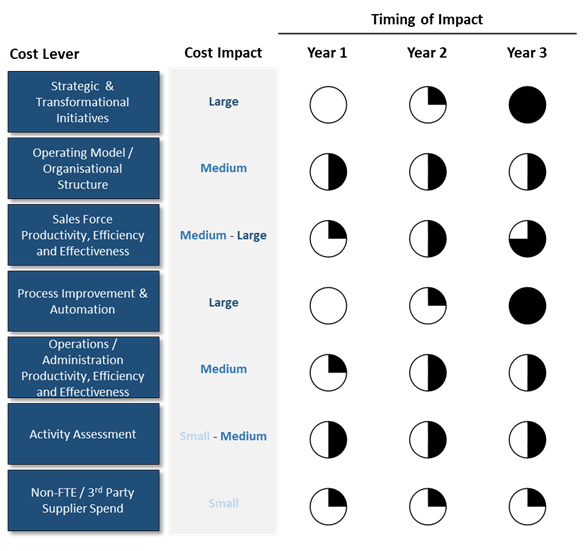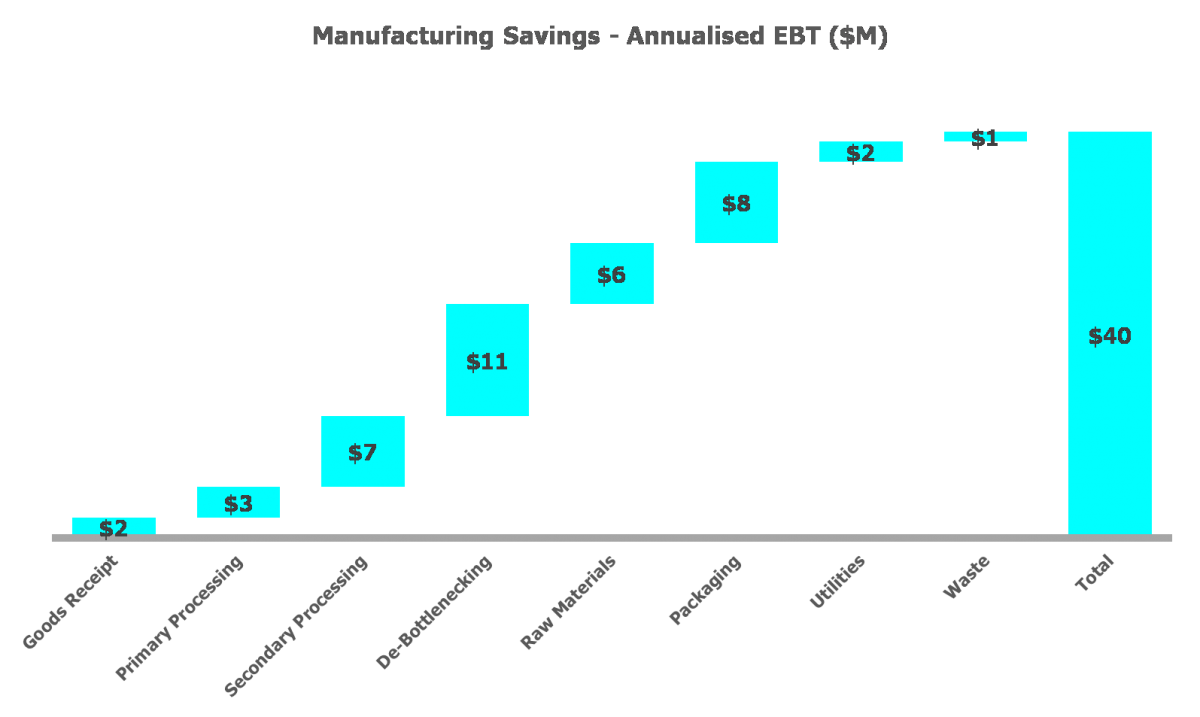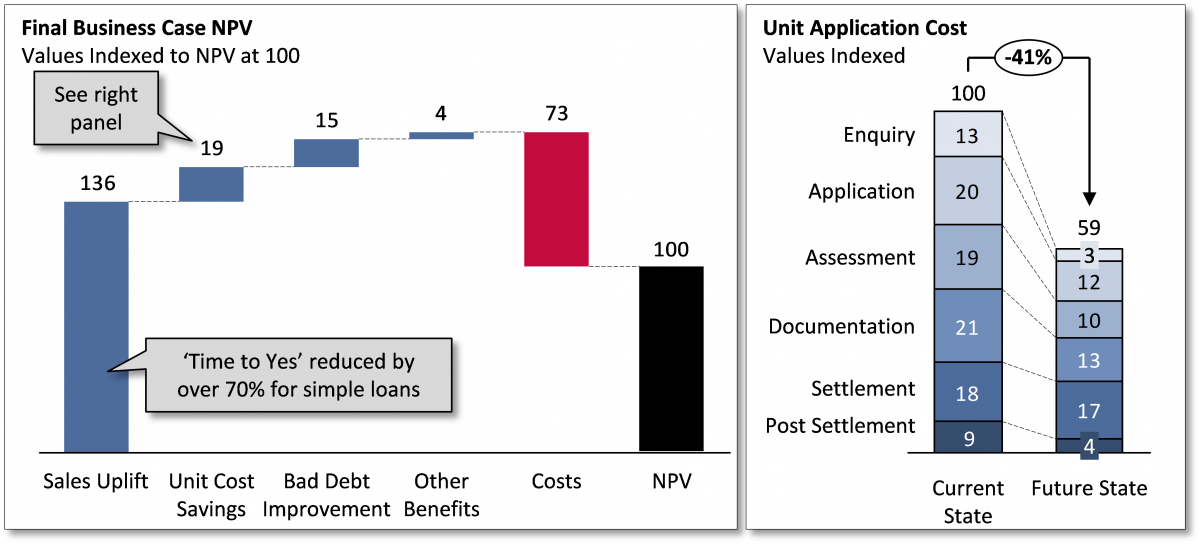The initial three-year programme achieved a reduction of over 25% over the three-year time horizon.

CONTEXT
Our client, a major Australian/NZ insurance and wealth management company, was facing serious strategic and financial challenges and needed to undertake a transformation of its business. CACE Partners was engaged to assist the client in achieving a step change in its cost structure whilst at the same time nearly doubling revenue, increasing adviser and customer satisfaction and improving employee engagement. Our first engagement of three years involved the design and implementation of a 3 year strategic cost reduction program to reduce absolute costs by 25%. Our second engagement of eighteen months involved the design and implementation of a strategic cost reduction program to reduce absolute costs by a further 10% over 2 years.
INSIGHTS / APPROACH
For both engagements, a joint CACE Partners/client team adopted a structured strategic cost reduction approach across all areas of the client’s Australian and NZ operations.
The key steps in the adopted approach included:
- the development of a market competitive cost-to-income ratio required over each of the following three years in the first engagement and two years in the second engagement
- the translation of the cost-to-income ratios to absolute dollar cost targets required over each of the following three years for the first engagement and two years for the second engagement, based on forecast income levels and target returns on equity
- the application of a structured cost reduction methodology across the entire organisation to identify initiatives to achieve the required absolute cost structure. The methodology focused on seven key work streams
- Strategic/Transformational opportunities
- Operating Model/Organisation structure optimisation
- Sales force productivity and efficiency improvement
- End-to-end process improvement & automation
- Operations consolidation & efficiency improvement
- Elimination of low/no value activities across the organisation
- Non-FTE/3rd party spend reduction
- the development of implementation plans and the setup of a programme management office to drive implementation of initiatives and track key benefits
RESULTS
The initial three-year programme achieved a reduction of over 25% over the three-year time horizon. The succeeding programme achieved a further reduction of nearly 15% over the two-year time horizon.
The achievement of the cost reductions utilised all seven levers. In the early years of the programme, the reduction in costs were achieved through low/no-IT initiatives, principally through non-FTE reductions, support function consolidation between Australia and NZ, elimination of low/no value activities, elimination of a layer of middle management and the sale of non-core assets. The later year cost reductions were achieved largely through the automation and redesign of key end-to-end processes, the outsourcing of several operational activities to lower cost locations and the outsourcing of several IT activities to a global third party.
The CACE Partners collaborative cost reduction approach was deployed to ensure management and staff were involved throughout.

CONTEXT
A leading Australian FMCG manufacturer was seeking to reduce overhead costs in response to revenue and margin pressure in its core categories. CACE Partners was engaged to assist the client reduce its overheads without damaging the business and in a way that didn’t alienate staff and destroy culture and goodwill. Specifically, the client wanted to ensure the savings were reasonable and sustainable, reflective of the environment in which they operated.
INSIGHTS / APPROACH
The CACE Partners collaborative cost reduction approach was deployed to ensure management and staff were involved throughout. Key process steps included –
- Agreed the savings target and supporting rationale
- Understood the business strategy for the next 3 years, to ensure resulting cost structure was aligned
- Broke the target down by business area and cost centre, adjusted to align with strategy
- Ran a series of workshops with management to develop savings hypotheses
- Applied a transparent and consistent risk assessment framework to all savings, aligned to business strategy
- Worked with the executive team to agree which savings were considered low or moderate risk, and which would only be pursed in the case of a ‘gloom’ or ‘doom’ scenario
- Built analytical support to quantify savings over following 3 years & steps required to implement
- Built implementation plans for all approved savings initiatives and supported finance team to load budgets
- $24M (21%) total, risk assessed savings identified, with $22M (19%) loaded into budgets
RESULTS
The programme identified reductions in operating costs across the bank that over three years, once inflation was offset, reduced the banks cost by 22%.

CONTEXT
Our client, a major Australian bank, was under-performing across several key aspects of its retail and commercial banking businesses—declining margins, small and declining market share in its core products, high cost to income ratio, poor customer satisfaction and unacceptable employee engagement. CACE Partners was engaged to assist the client in achieving a step change in its cost structure whilst at the same time improving revenue, margins, customer satisfaction and employee engagement.
INSIGHTS / APPROACH
A joint CACE Partners/client team adopted a structured strategic cost reduction approach across the entire bank.
The key steps in the adopted approach included:
- The development of a market competitive cost-to-income ratio required over each of the following three years
- The translation of the cost-to-income ratios to absolute dollar cost targets required over each of the following three years, based on forecast income levels and target returns on equity
- The application of a structured cost reduction methodology across the entire bank to identify initiatives to achieve the required absolute cost structure. The methodology focussed on six key work streams
- Organisational structure optimisation
- End-to-end process improvement, particularly for mortgages and commercial loans
- Operations consolidation & optimisation
- IT operating model
- Support functions / shared services Improvement
- Non-FTE spend reduction.
- The design of the go-forward approach and capability for Process Management across the Bank
- The development of implementation plans and the setup of a programme management office to drive implementation of initiatives and track key benefits
A highly collaborative approach was taken to leverage management and SME expertise.

CONTEXT
Our client, a leading Australian FMCG manufacturer and packaged fruit processor, was faced with a large legacy manufacturing cost base, which was impacting competitiveness in the face of falling volumes in its core products. Specifically, the client was keen to understand the opportunities to reduce the cost impact of seasonality on its business, whilst also reducing manufacturing costs in general.
CACE Partners was engaged to work with management to develop a strategy to de-seasonalise operations and to identify opportunities reduce manufacturing costs.
INSIGHTS / APPROACH
A highly collaborative approach was taken to leverage management and SME expertise:
- End to end manufacturing strategy developed to significantly reduce the cost impact of seasonality on the business
- 10 workstream established across operations and supply chain
- Collaborative idea generation workshops held in each stream
- 200+ saving hypotheses identified for assessment
- Collaborative approach included risk assessment of each initiative, with a management owner appointed for each hypothesis taken through to exco for approval
- 50+ hypotheses taken through to exco approval and included in the capital masterplan
- $35M+ in annualised operational savings (~15% of operational cost base)
RESULTS
Over the course of 18 months, a joint CACE Partners and client team worked to deliver the client’s largest project at the time.

CONTEXT
Our client, a major Australian Bank, was severely underperforming in its core mortgage product. It experienced below system mortgage growth in a rapidly expanding market, poor relative market share and higher than average levels of non-performing loans. Constrained by an end-to-end mortgage process that was highly manual and paper based, and that was underpinned by antiquated systems, its mortgage offer could not competitively satisfy key customer buying criteria, particularly with respect to its ‘Time to Yes’ and ‘Time to Docs’. CACE Partners was engaged to assist with a complete end-to-end redesign of the mortgage process and transform the way lending was undertaken.
APPROACH
Over the course of 18 months, a joint CACE Partners and client team worked to deliver the client’s largest project at the time. Over three phases, we delivered:
- Pre-Work: Designing a structured approach to the-end-to-end process redesign
- Diagnostic: Developing the appropriate frameworks, factbase and metrics to understand the current state of the process
- RFI: Assisting with vendor evaluation (both financial and non-financial) and negotiation strategy
- Business Case (Draft and Final): Leading the overall development of the business case including financial modelling, bottom up end-to-end identification of benefits, and preparation of business case materials for the Board of Directors for sign-off

RESULTS
The final business case yielded significant financial benefits:
Overall operating costs reduced by 29%, after allowance for inflation, whilst service level adherence improved and rework levels plummeted.

CONTEXT
Our client, the operations area of a large Australian wealth management business, was experiencing increasing unit costs, poor service outcomes to customers and increasing rework rates. The CEO engaged CACE Partners to undertake a review of the operations areas to reduce absolute costs in the two operations centres by 20% whilst improving customer service and rework rates.
INSIGHTS / APPROACH
CACE Partners undertook a diagnostic to understand four key elements:
- Transaction volume trends
- Cost structure – operating costs, FTE’s and unit costs (cost per transaction)
- Service metrics and trends – percentage of work items processing within both internal and external service level agreements
- Quality metrics and trends – percentage of errors captured by rework and external reporting.
The diagnostic quickly identified the need for the development and implementation of a management toolkit. The management and staff in the operations areas lacked transparency in key cost, service and quality measures. Thus, they were unable to manage their areas based on data/facts.
CACE Partners worked with the client to introduce a management toolkit with the following key characteristics:
- All activities within the operations areas were broken down into three groups (core workflow, core non-workflow, overhead)
- Productivity targets by activity (expected effort time) were developed for each activity within each group via a combination of data analysis and activity observation
- Data capture tools and forecasting, planning and reporting was established at an individual, team, area and department level
- A mixture of formal training and on the floor coaching was provided to team members and managers to deploy the approach over a 3-month period, supported by an extensive communication strategy
- Managers were measured on their maturity on a weekly basis as they obtained mechanical, conceptual and then ownership compliance of the tools and processes to achieve behavioural change in their teams.







